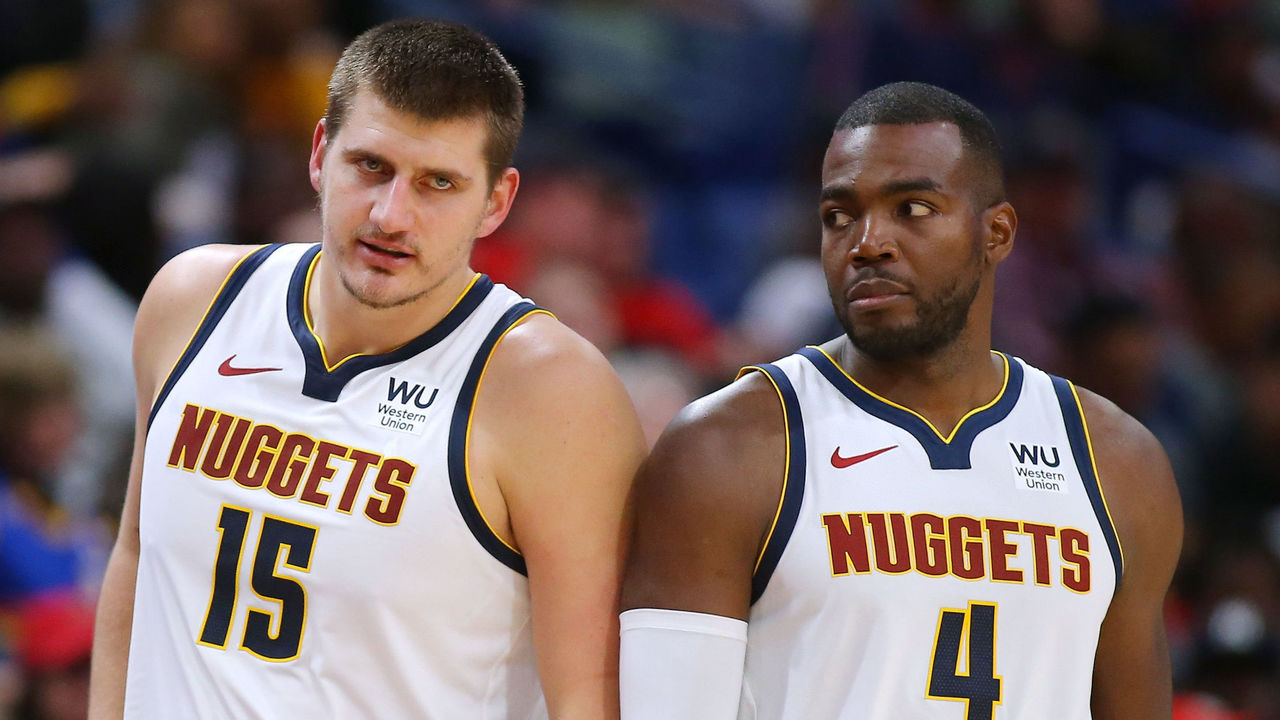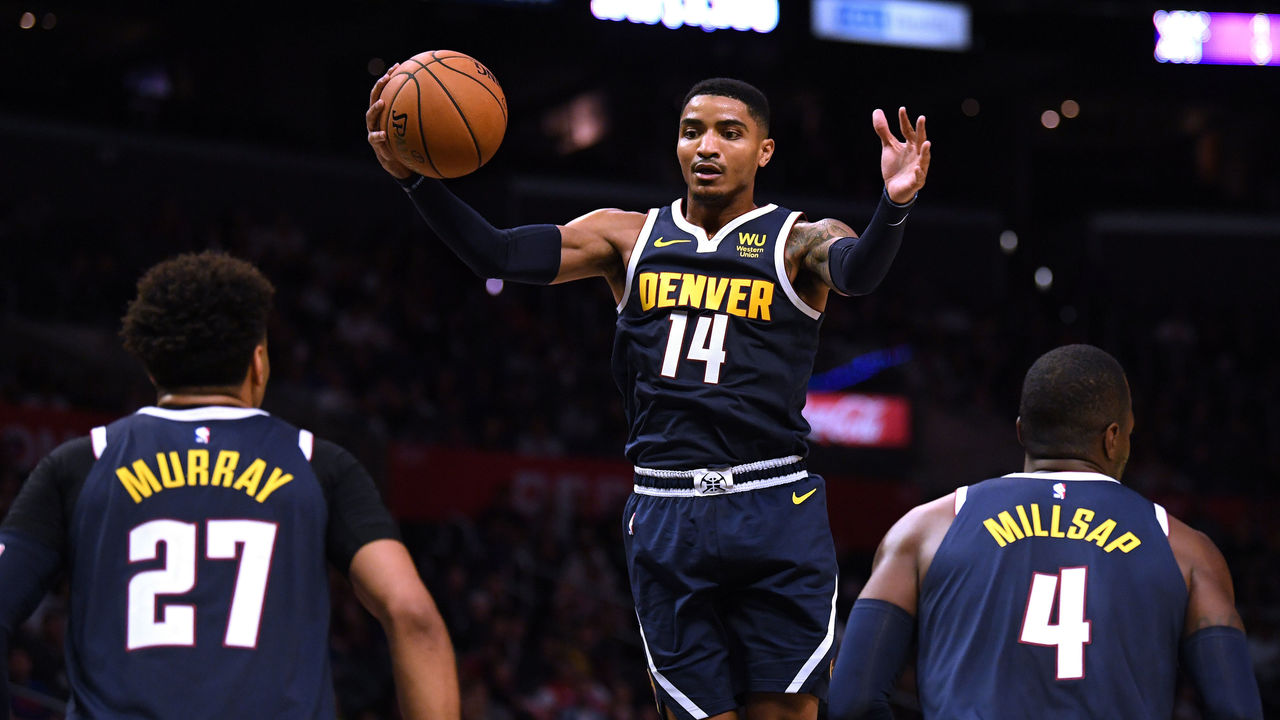The Nuggets' defense has been very lucky and very, very good
After a breakthrough campaign in which they came up a win short of the West finals, the Denver Nuggets came into this season as stealth championship contenders. That case was built largely on the potential of their offense, which ranked sixth in the NBA a year ago and was returning virtually the same cast of characters.
In Nikola Jokic, they have a hub who can play inside and out, pass as well as anyone in the league, and play the role of big man or guard. Even absent a second offensive star, Denver has the right kind of complementary talent around him; smart cutters, good spot-up shooters, and capable secondary creators. But the Nuggets have sputtered at the offensive end thanks to a confluence of factors including a suboptimal shot profile and the fact Jokic, still clearly playing his way into shape, hasn't been the bruising post presence he was last year. In spite of that, the team is 13-3, good for second in the Western Conference, a start spearheaded by the league's top-ranked defense.
For a while, conventional wisdom held that you couldn't build an elite defense around the earthbound Jokic. Then the Nuggets surprised people by finishing 10th in defensive rating last season, a year after ranking 25th. And rather than coming back down to earth in 2019-20, they've gotten even better on that side of the ball. How, exactly, are they doing this?
The simplest part of the answer is luck. The Nuggets rank 23rd in opponent location eFG% - a Cleaning the Glass statistic that quantifies the expected value of the shots a team surrenders - which is a short way of saying they allow a lot of 3-point attempts and a lot of shots at the rim. And it's not like they've defended the rim especially well (they rank 21st in defensive field-goal percentage inside the restricted area). They force about an average number of turnovers and are middle of the pack when it comes to sending opposing teams to the free-throw line. Basically, opposing teams are just clanking jump shots left and right.

When stripping out garbage time and end-of-quarter heaves, opponents have shot 31.1% from 3-point range and 33.9% from mid-range against the Nuggets, the lowest such marks in the league, per Cleaning the Glass. For reference, the lowest defensive percentages in those categories last year were 34.4% and 38%, respectively.
So, regression is seemingly in store. But that doesn't mean this start has been a complete mirage. It seems notable that the aforementioned league-low opponent 3-point percentage last year belonged to the Nuggets as well. And while precedent would tell you that fact on its own isn't predictive, these Nuggets also pass the eye test in myriad ways, suggesting they can continue to suppress their opponents' efficiency to at least some degree.
Start with Paul Millsap, the straw that stirs Denver's defensive drink. Even in his age-35 season, Millsap remains as impactful a defender as ever thanks to his intuition, smarts, and still-credible physical gifts. He has an uncanny knack for sniffing out and blowing up plays, and a prescient sense of timing for when to abandon his man and help. Few players are better at anticipating and stymieing pick-and-roll dives or back cuts from the weak side. When he commits to helping, there are no half-measures; he goes full bore. And he does it while making hardly any mistakes:
The Nuggets can use him as a wing defender whose primary task is to bottle up ball-handlers or dig down from the strong side, or as a help defender who roves off a non-shooter and swoops in to disrupt a play at the rim (as he did to such great effect in last year's playoffs). Often, he does both on the same possession. There's a nice symbiosis between him and Jokic. When Jokic gets dragged out to the perimeter, Millsap quarterbacks rotations and anchors the backline behind him, and when Jokic hangs back at the rim, Millsap can switch out on the fly.
It's not an accident the Nuggets have allowed just 95.9 points per 100 possessions with Millsap on the floor (10.8 per 100 fewer than they allow with him on the bench), even though opponents have actually shot jumpers far more accurately during his minutes.
One possible explanation for the miserable opponent jump shooting overall is the fact the Nuggets are an aggressive defense like they were last year, when they also happened to be unusually good at tamping down their opponents' 3-point proficiency. They hedge, blitz, send hard double-teams, and apply relentless ball pressure. In doing so, they're often able to force the ball out of the hands of strong shooters and into the hands of weaker ones.
They're also more flexible stylistically than they were last year. They more frequently get conservative with their pick-and-roll coverages and have their bigs - particularly Jokic - drop back (though he still doesn't drop as deep as a lot of teams have their centers do). That means letting their opponents keep the ball in their best players' hands more often, but the Nuggets still find ways to make those players' lives difficult; rear-view contests, guys stunting from the wing, the dropping big man staying just close enough to ball-handlers to make them think twice. This, for instance, looked like a pretty clean and routine pull-up for Kemba Walker, but Jokic, Will Barton, and Gary Harris gave him a lot to process before he let it fly:
The Nuggets' dominant defensive performance last week against the Houston Rockets - a team that's been their kryptonite in the recent past, having won 10 of their previous 11 meetings while posting a 124.5 offensive rating against them last year - felt particularly telling, even if the Rockets are still trying to nail down their style and identity in the Russell Westbrook era.
That was one of the matchups in which the Nuggets hewed closest to a conventional drop-back scheme in pick-and-rolls involving Jokic, even against the threat of James Harden's pull-up three. It made sense to try something different after Harden shredded their constant traps last year, piling up some of his highest assist games as his teammates dined out on open threes and dunks. This time, the Nuggets aimed to limit his playmaking options while amping up their man-to-man aggressiveness and sent additional defenders at him from up top rather than from below.
Harden probably should've pulled up for three here, but Barton and the rest of Denver's wings had been hounding him all game. He seemed almost surprised not to find Jokic in his direct airspace as he came off the screen, so he hesitated and wound up having to pull the ball back out:
Barton eventually drew an offensive foul on an illegal screen from Tyson Chandler. Harden finished the game with more turnovers than assists.
Even in their more conservative pick-and-roll coverage, the Nuggets found spots to pressure him, trusting those rotations to neutralize Houston's subsequent man advantage. The strategy of running a second guy at Harden 25 feet from the basket took center stage in the Rockets' ensuing game against the L.A. Clippers - both because it produced a scrutinized end-of-game play, and because Harden griped about it afterward - but the Nuggets selectively (and successfully) employed the tactic two nights earlier:
A defense functions properly only when its smalls and bigs are working in concert. If either piece of that machinery fails, the whole apparatus is liable to fall apart. Denver's has kept humming so far because its guards are doing their part. Harris has been particularly sticky while chasing a smattering of the league's best scorers through mazes of screens night after night, but he's not the only one. Barton has been instrumental, and so has Jamal Murray - whose defense looks much improved, especially when it comes to activating his hands and getting deflections and steals.

It all makes Jokic's life quite a bit easier. In spite of his limitations defending in space, pick-and-roll ball-handlers have scored just 0.75 points per possession against the Nuggets, the second-best mark in the league, according to Synergy. More than anything, that's a testament to the point-of-attack defenders who've fought like crazy to stay attached or pursue ball-handlers around screens. (Relatedly, no team has been better at defending dribble-handoffs.)
Jokic, for his part, has done a nice job sliding his feet, staying in front, and blotting out daylight when guards try to turn the corner or pass the ball around him. And when his hedges and traps break, the Nuggets have scrambled beautifully on the back end. Throw almost any combination of Millsap, Harris, Murray, Barton, Jerami Grant, Torrey Craig, or Mason Plumlee into a shorthanded situation and they'll communicate, help the helper, and make crisp, pinwheel-like rotations.
This kind of stuff is difficult to quantify but shouldn't go unrecognized when we try to project just how significantly a team's outlier numbers will regress. The Nuggets have a way of making opposing teams feel harried, rushed, and under pressure. They force those teams to be precise in their ball movement and to work hard for their shots, even if those shots ultimately wind up coming from ostensibly profitable spots on the floor.
Is it crazy to think that the requisite work is contributing to their opponents' lousy shooting, the way it may also have done last year? Can a team make its own luck?
If the Nuggets keep doing what they've been doing at the defensive end and continue to be rewarded with the results that ought to be beyond their control, we may have ourselves an answer.